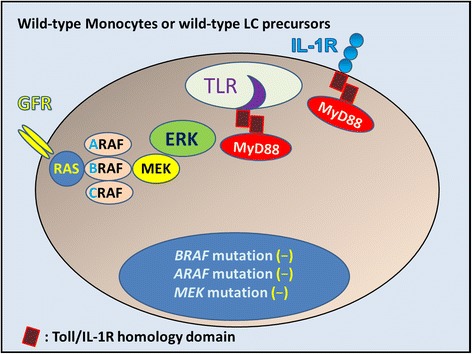Figure 2.

Wild-type monocytes, wild-type LC precursors, or wild-type immature Langerhans cells without mutations. In these cells, mitogens such as growth factors bind to and activate cell-surface receptors (GFR: growth factor receptor) that induce signaling through a complex consisting of adaptor proteins and exchange factors to activate RAS (Blue circle) on the inner surface of the cell membrane. Once activated, RAS binds to and activates the RAF family of proteins, including BRAF, which subsequently phosphorylates and activates MEK. Activated MEK subsequently phosphorylates and activates ERK. Activated ERK phosphorylates numerous substrates within the cytoplasm and nucleus, promoting cell division and enhancing survival, movement, and differentiation. In the case of Merkel cell polyomavirus (MCPyV) infection, some LCs may present MCPyV antigen, inducing adaptive immunity through Toll-like receptors (TLRs). IL-1 is the first cytokine secreted in response to sensitizers. IL-1 binds to IL-1 receptor (IL-1R) and promotes LC migration from sentinel tissue such as the skin. MCPyV interferes with LC function and maturation to evade immune surveillance, which might allow infection by inhibiting NF-κB essential modulator (NEMO) and down-regulation of TLR9.
